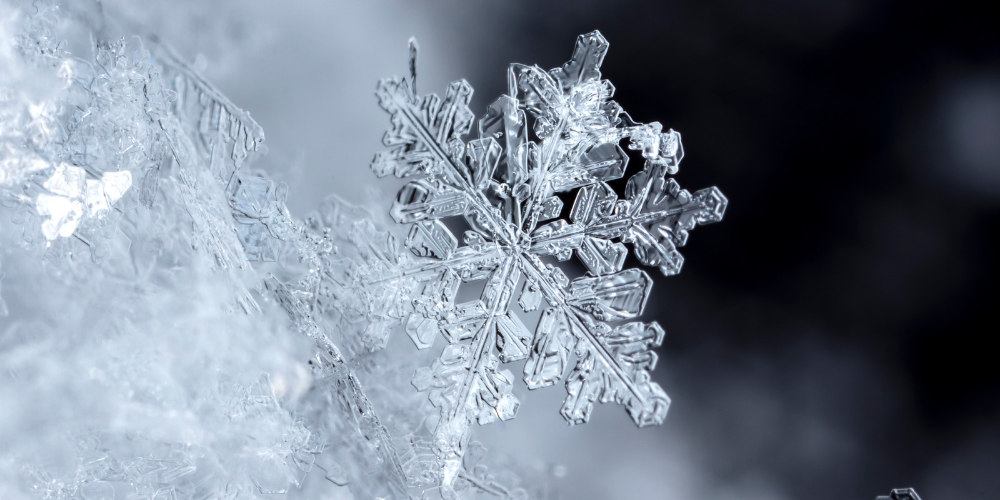Snowflakes are one of the most fascinating phenomena of the winter period. Each of them is unique and wonderful, but how exactly are they created?
In this article, we'll explore the conditions necessary for
snowflakes to form , their growth process, and the structure that makes them so special.
While snowflakes are often associated with the winter holidays, it's important to remember that these ice crystals are also present outside of the Christmas season and can be enjoyed year-round. However, it is true that snowflakes are often used as
DIY decorations and cute
Christmas placeholders, to add some extra flair to the table during the festive season.
Tackle the winter chill and cut heating costs with a simple upgrade: explore our range of
door draft excluders in our dedicated section, perfect for keeping the warmth in and the cold out of your home!

What is a Snowflake?
A snowflake is a
snow crystal that forms when atmospheric moisture freezes around a particle of dust or salt. Each snowflake is made up of a series of branches that extend from the six main arms, creating a
star-shaped structure.
How is a snowflake formed?
Forming a snowflake requires
specific weather conditions , a nucleation process, and growth of the flake.
a. The weather conditions
For a snowflake to form, there must be
high humidity in the air and temperatures below freezing . This often happens in clouds of cold air that are found at high altitudes.
b. The nucleation process
Once the weather conditions are ideal, the water turns into vapor and freezes around a particle of dust or salt suspended in the air. This process is called
nucleation .
c. The growth of the flake
After nucleation, the snow crystal begins to grow due to the
deposition of water vapor molecules on its surface. The final shape of the flake depends on factors such as temperature and air humidity.
d. The final shape of the bow
Depending on the weather conditions, a snowflake can take on
different shapes , including the classic six-armed star shape, but also more complex or needle-like shapes.
The structure of snowflakes
The
structure of a snowflake is what makes it so unique and fascinating. Each flake has six-arm symmetry, giving it a star shape. Each branch of the flake is made up of several ice spheres, growing out of the central core.
The exact shape of the flake depends on the weather conditions in which it formed.
a. The six-arm symmetry
The six-armed symmetry of snowflakes is a result of the crystalline structure of ice, which is shaped like a hexagon. This means that each snowflake branch must be exactly the same type and size as the other five.
b. The complexity of the structure
The structure of snowflakes is incredibly complex and intricate. There are many variables that affect the final shape of the flake, such as temperature, humidity and wind speed. The position of the nucleating particle within the cloud can also influence the shape of the flake.
The importance of snowflakes
Snowflakes are important for many reasons, three being the main ones:
- They are an essential source of fresh water for many communities that depend on snow for their drinking water supply;
- They have a significant impact on the snow ecosystem , influencing its density and structure;
- They are a source of inspiration for scientists, photographers and artists in general. Studying snowflakes can help to better understand ice crystal formation and the physical properties of snow.
Conclusions on how snowflakes are created
To conclude we can say that snowflakes are a
wonderful example of the beauty of nature . Their formation depends on many variables, but once the right conditions are met, the snowflake growth process can create incredibly complex and unique structures.
The
beauty of snowflakes can inspire both science and art, demonstrating how fascinating and important nature is.
Most common questions about snowflakes
Are all snowflakes the same?
No, each snowflake is unique and has its own shape and structure.
What are the ideal weather conditions for snowflakes to form?
Ideal weather conditions for snowflakes to form include high humidity in the air and sub-zero temperatures.
Do snowflakes always have a six-branched shape?
No, depending on the weather conditions, snowflakes can take on different shapes.
How is snowflake formation studied?
Snowflake formation is studied through direct observation and microscopic analysis of ice crystals.
Are snowflakes important to the ecosystem?
Yes, snowflakes have a significant impact on the snow ecosystem, influencing its density and structure.




